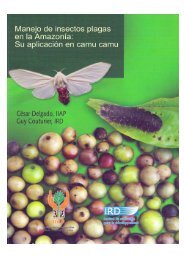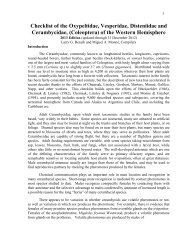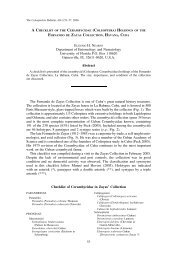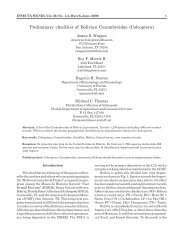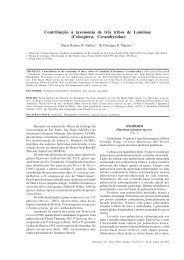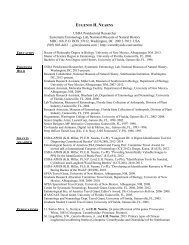Create successful ePaper yourself
Turn your PDF publications into a flip-book with our unique Google optimized e-Paper software.
LAWRENCE S. DILLON <strong>AND</strong> ELIZABETH S. DILLON 141<br />
J)IIDAMUS Dillon and Dillon, gen. nov.<br />
The distinguishing characters of this genus are the more oblong<br />
form of body; front broad, nearly as wide as long, very slightly<br />
narrowed below eyes ; eyes with lower lobe ovate, small, subequaJ<br />
in height to the gena j pronotum cylindrical, sides distinctly excavated,<br />
disk with five tubercles; elytl'a with base rugosely punc·<br />
tate, without granules j meso· and metatibiae expanded in male.<br />
Moderate-sized, elongate·ovate, robust. Head with front nearly as broad as<br />
long, sides parallel, very slightly narrowed below eyes; geM elongate; eyes with<br />
lower lobe ovate, subequal in height to gena; antennal tubercles promillent, well<br />
separated, only very feebly produced at apex in mnle, not at all in femalc. Pro<br />
notum transverse, cylindrical, sides excavated medially, vrith n small tubercle just<br />
above angulation of procoxae, apex narrower than basc; disk with five small but<br />
distinot tubercles. Scutellum transverse. Elytra feebly widened at middle, apices<br />
separately rounded ; disk at base more or less rugosely punctate, without distinct<br />
granules; basal gibbosities broad, feebly elevated; humeri prominent, angle with n<br />
feeble, obtuse tubercle. Presternum simple, narrow, widened behind middle; meso<br />
sternal process moderately broa.d, si des feebly widened apically, apex hilobedly<br />
emarginate. Legs moderately long; procoxae globose, with a Email, distinct tubercle<br />
in male, unarmed in female; femora robust, gradually clavate; meso- and meta<br />
tibiae expanded apically in male. Antcnnae about one and one-half times body<br />
length in male, as long as body in female; scape reaching nearly to middle of pronot-urn,<br />
strongly clavate from middle; third segment slightly longer than scape,<br />
feebly sinuate, remaining segments gradually shorter.<br />
GEXOTYPE : lJ1idam1ls hecabe Dillon and Dillon, spec. nov.<br />
KEy TO SPECIES<br />
Antennae with third segment at base and Utrsal claw segment basally testaceous;<br />
e1ytral pale fascia indistinct . . " .............. ' . ............ satitaremensi8.<br />
Antennae with third segmcnt at base and tarsal claw segment basally not pale;<br />
elytral pale fascia distinct . . . . . . . . . . . . . . . . . . . . . . . . . . . . . . . . . . . . . . . MC{Jbe.<br />
Midrunus hecabe Dillon and Dillon, spec. nov.<br />
PLATE IX, FIGURE 12.<br />
Closely allied to Esonius panopus but differing in that the base<br />
of elytra is simply punctate; pronotum with sides excavated, lateral<br />
tubercle more ventral ; eye subequal to gena, only very feebly<br />
elongate.<br />
MALE. Elongate-ovate, robust, subconvex; dark reddish-brown to fuscous.<br />
Head with pubescence which va.ries from a tawny-gray or brownish.gray to ocb·<br />
raceous ; front slightly variegated with dnrk brownish-gray, the basic pubescence<br />
condensed to outline the eye. Pronotum deep grayish·brown, irregularly variegated



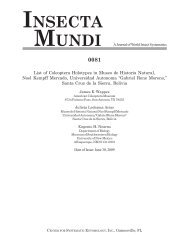
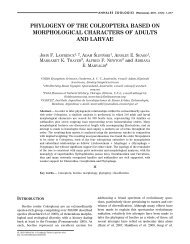


![Coleoptera. Vol. I. [Longicornia. Part I.]](https://img.yumpu.com/41202793/1/180x260/coleoptera-vol-i-longicornia-part-i.jpg?quality=85)
